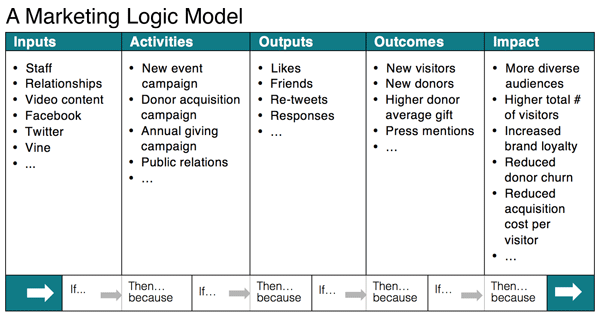I’ve been doing some extra reading on social media, online marketing, and online experiences as we prepare for our first presentation of Digital Strategies in Denver in October. One of the readings we are using, “Can You Measure the ROI of your Social Media Marketing?” got me thinking. The authors surface the classic problem in marketing: how do you demonstrate that specific communications tactics generate the sales, visitors, new audiences, new donors, and other business results you want? What got me thinking was the shape this problem takes with social media marketing.
We measure what we can easily measure: clicks, time on site, friends, tweets. These immediate, easy measures often take over the discussion, becoming an end in themselves in place of the real goals: brand awareness, connectedness, loyalty, attendance, and the like. The connection from marketing activities to these big results is just too hard to see or prove. We bump heads working across our organizations because we don’t agree, or don’t communicate clearly, about the real goals for the communications activities and how we will know if we are succeeding.
All of which sounds exactly the same to me as the conversations I have about program design and program evaluation. Outputs such as the number of children in attendance are immediate and easy to measure. Impact is hard to measure or even impossible, is inextricably mixed up with other causes and factors outside our control, and may not be clear until years down the road. So program outputs become the coin of the realm, conversation drifts away from real impact, and we keep bumping heads.
A quick sketch of a logic model helps me keep program activities and conversations on target. But I don’t think of logic models as part of my marketing toolkit and can’t think of a time I’ve seen one used in marketing plans. I think this could work. The “outputs” would be the typical social media and marketing metrics: tweets, retweets, friends, hits, views, and so on. The “outcomes” and “impacts” would be the near-term and longer-term business results you are trying to achieve.
A marketing logic model would serve as a plan and a reminder of 1) what you are really trying to achieve and 2) the logical connection (which may not be directly demonstrable) that you hypothesize leads from a set of marketing activities to a set of organization results. It would focus assessment. If you are not hitting your output measures for your marketing activities, then you know you have a tactical problem. How do you change your communications tactics to achieve the outputs your logic tells you are needed to realize your outcomes? If on the other hand you are hitting those outputs but not seeing the outcomes or impacts you targeted, then the discussion needs to be about the marketing logic not the tactics. Can this set of marketing activities really result in the desired outcomes and if not why not?
We have these conversations all the time. There is nothing new in that. But without a simple way to capture and talk about the tactics, the metrics, and the logic, the conversations can spin round and round on themselves. With all those pieces laid out on one page and a structured way to talk about them, my bet is we can all save time, make better investments, and avoid some bruises.

